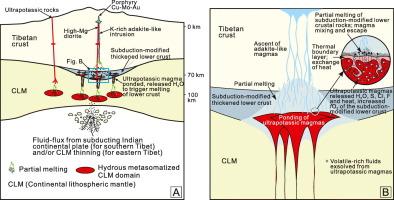Post-collisional porphyry copper deposits in Tibet: An overview
IF 10.8
1区 地球科学
Q1 GEOSCIENCES, MULTIDISCIPLINARY
引用次数: 0
Abstract
This paper presents a review of the geology and geochemistry of post-collisional PCDs in Tibet, including their spatial–temporal distribution, features of the ore-forming porphyries, magmatic origin and evolution, water–metal–S sources, alteration and mineralization features, fluid sources and evolution, conditions of Cu–Mo mineralization, and geodynamic models of their formation.
The post-collisional PCDs in Tibet contain total resources of ∼46 million tonnes (Mt) Cu at an average grade of 0.3–0.6 % Cu. They are mainly concentrated in the Gangdese, Yulong, and Ailaoshan–Red River belts, with ages of 30–13, 43–37, and 36–34 Ma, respectively. Their ore-forming porphyries have compositions that vary from granodiorite to monzogranite, syenogranite, and granite, and are high-K calc-alkaline to shoshonitic, with adakite-like signatures and highly variable Sr–Nd–Pb–Hf isotopic compositions. The ore-forming porphyries were mainly generated by partial melting of subduction-modified, thickened mafic lower crust with contributions from metasomatized lithospheric mantle. The causes of lower-crustal melting include asthenospheric upwelling associated with delamination of lithospheric mantle or slab tearing/break-off, and/or underplating of mafic magmas derived from metasomatized subcontinental lithospheric mantle. Ore-forming metals and S were mainly sourced by remelting of sulfide phases introduced into the lower crust during pre-collisional arc magmatism. Water necessary for mineralization was concentrated by dehydration reactions in the upper part of the subducting continental plate and/or degassing of water-rich ultrapotassic and/or alkaline mafic magmas derived from the mantle.
Similar to subduction-related PCDs, post-collisional PCDs in Tibet exhibit typical alteration zoning from inner potassic to outer propylitic zones, but with more intense overprinting of phyllic alteration on the former two alteration zones, likely due to higher rates of syn-mineralization uplift. Copper mineralization in post-collisional PCDs is mainly associated with phyllic alteration (particularly chlorite–sericite alteration) and, to a lesser extent, with potassic alteration, which is different from the typical association with potassic alteration in subduction-related PCDs. The initial ore-forming fluids in the post-collisional PCDs are single-phase, intermediate-density, and low-salinity fluids derived from evolved magma reservoirs. With ascent and decompression, the single-phase fluids separate into immiscible metal-rich hypersaline liquids responsible for potassic alteration and a low-salinity vapor. The evolved single-phase fluids are possibly diluted by meteoric waters, which leads to phyllic alteration. Cooling of magmatic–hydrothermal fluids may control metal precipitation in some post-collisional PCDs.
The development of post-collisional PCDs in Tibet indicates that other collision zones worldwide also have the potential to host economic PCDs. On a regional scale, high whole-rock Sr/Y, V/Sc, Eu/Eu*, and 10,000*(Eu/Eu*)/Y ratios; high zircon Eu/Eu* and 10,000*(Eu/Eu*)/Y ratios; high ΔFMQ values; high apatite SO3 contents; and zircon Lu–Hf isotopic mapping can be used as fertility indicators during regional exploration for post-collisional PCDs. On a district scale, field geological and geochemical methods are effective in searching for outcropping or near-surface post-collisional porphyry mineralization.
There are many issues to be clarified by future research, such as the mechanisms of Cu enrichment and migration in the lower crust; sources of Cl; mechanisms of Cu precipitation; occurrence, resource potential, and enrichment processes of critical elements (Re, Se, and Te); and use of mineral chemistry to aid PCD exploration.

西藏碰撞后斑岩铜矿床:概述
本文综述了西藏碰撞后多金属结核的地质和地球化学特征,包括其时空分布、成矿斑岩特征、岩浆成因与演化、水-金属-S来源、蚀变与成矿特征、流体来源与演化、铜-钼成矿条件及其形成的地球动力学模型。它们主要集中在冈底斯带、玉龙带和艾劳山-红河带,年龄分别为30-13、43-37和36-34Ma。其成矿斑岩的成分从花岗闪长岩到单斜花岗岩、正长岩、花岗闪长岩不等,为高K钙碱性至shoshonitic,具有阿达克岩样特征,Sr-Nd-Pb-Hf同位素成分变化很大。成矿斑岩主要是由俯冲改造、增厚的岩浆岩下地壳部分熔化产生的,其中也有变质岩石圈地幔的参与。下地壳熔融的原因包括与岩石圈地幔分层或板块撕裂/断裂有关的星体层上涌,和/或来自变质次大陆岩石圈地幔的岩浆下溢。成矿金属和 S 主要来源于碰撞前弧状岩浆作用期间引入下地壳的硫化物相的重熔。成矿所需的水是通过俯冲大陆板块上部的脱水反应和/或来自地幔的富水超钾盐岩浆和/或碱性岩浆的脱气作用而富集的。与俯冲相关的多金属结核类似,西藏的碰撞后多金属结核表现出典型的从内侧钾盐带到外侧丙铁矿带的蚀变分带,但前两个蚀变带上的植蚀作用更为强烈,这可能是由于同步成矿上升速率较高所致。碰撞后多金属结核中的铜矿化主要与辉绿岩蚀变(尤其是绿泥石-闪长岩蚀变)有关,其次与钾长石蚀变有关,这与俯冲相关多金属结核中典型的钾长石蚀变不同。碰撞后多金属结核中最初的成矿流体是来自演化岩浆储层的单相、中等密度和低盐度流体。随着上升和减压,单相流体分离为造成钾盐蚀变的不溶性富金属超盐液体和低盐度蒸汽。演化出的单相流体可能会被陨石水稀释,从而导致植蚀作用。岩浆-热液的冷却可能会控制某些碰撞后多金属结核的金属沉淀。西藏碰撞后多金属结核的发育表明,世界上其他碰撞带也有可能孕育经济型多金属结核。在区域范围内,高全岩Sr/Y、V/Sc、Eu/Eu*和10,000*(Eu/Eu*)/Y比值;高锆石Eu/Eu*和10,000*(Eu/Eu*)/Y比值;高ΔFMQ值;高磷灰石SO3含量;以及锆石Lu-Hf同位素图谱可作为碰撞后多金属结核区域勘探的肥度指标。在地区范围内,野外地质和地球化学方法可以有效地寻找露头或近地表的碰撞后斑岩矿化。未来的研究还有许多问题需要澄清,例如下地壳中铜的富集和迁移机制;Cl 的来源;铜的沉淀机制;关键元素(Re、Se 和 Te)的出现、资源潜力和富集过程;以及利用矿物化学来帮助 PCD 勘探。
本文章由计算机程序翻译,如有差异,请以英文原文为准。
求助全文
约1分钟内获得全文
求助全文
来源期刊

Earth-Science Reviews
地学-地球科学综合
CiteScore
21.70
自引率
5.80%
发文量
294
审稿时长
15.1 weeks
期刊介绍:
Covering a much wider field than the usual specialist journals, Earth Science Reviews publishes review articles dealing with all aspects of Earth Sciences, and is an important vehicle for allowing readers to see their particular interest related to the Earth Sciences as a whole.
 求助内容:
求助内容: 应助结果提醒方式:
应助结果提醒方式:


